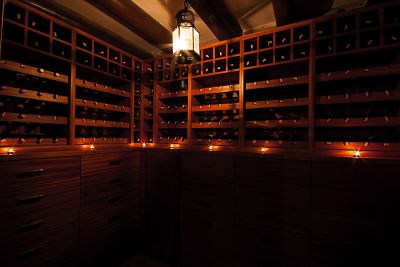If we are wine enthusiasts and we like to have a wide selection at home, we should think about the best way to preserve it or, if we want to, adapt a place where it can age in the bottle.
Nothing better than installing a home wine cellar. No matter how small the space is, at Tecnicold we install all types of wine cellars, ranging from large structures for producers to small wine cellars in private homes.
In addition, this type of installation adds value to the home, both economically and aesthetically, adding personality and character.
What do we have to consider when installing a wine cellar at home?
As in any wine cellar, temperature, light and humidity is what needs to be controlled. This is the purpose of a wine cellar: to protect the content from external influences.
In large natural cellars dug underground, these variables can be naturally controlled. These are what we call passive cellars. But in a house, it is necessary to find the most suitable place, the most stable, and provide the space with good insulation and work the cooling system to maintain the temperature between 7°C and 18°C and relative humidity at around 70%, although this last point is a matter of debate.
Another factor is odours. Corks allow small amounts of gases to pass into the bottle: nothing to worry about in a controlled environment. But we must prevent strong odours such as bleaches or paints entering our installation, as these could spoil the bouquet of our wine selection.
Natural light has a negative effect on wine. One of the main reasons for building wine cellars is to preserve the bottles from direct sunlight, since ultraviolet rays affect their stability and can affect the aroma and bouquet.
Finally, we must avoid locations that could experience strong or continuous vibrations caused by electrical equipment such as refrigerator motors, washing machines, dryers… that could spread these vibrations through walls or floors to our wine cellar.
Materials used in the construction of a wine cellar.
It is important to take into consideration the areas to be insulated. A cellar has walls, floor, ceiling and door. Each part needs specific elements for insulation.
In certain projects, a wooden framework covering walls and ceiling will be useful both to divide the space and to support the insulating materials: a vapour barrier (there are different solutions on the market and we will offer you the most suitable for your project) placed on the inside will prevent condensation.
Exposed areas, such as the floor or part of the ceiling, can be insulated using sealant coatings, preventing dampness. Floors can be covered with wood or tiles.
Doors should be exterior and perfectly sealed to keep air infiltration, odours and temperature changes to a minimum. If we use glass, it must be insulating, using dehydrated gas between the two layers of glass. A proper insulation of the door area will prevent the refrigeration unit from overworking to compensate for changes in temperature and humidity. Together with good maintenance, the equipment will be kept in perfect condition longer.
Finally, the wine racks. We can choose between installing the classic wooden bottle racks or the more fashionable metal ones. If we use light to backlight them, we must take into account that no heat is provided.
Refrigeration system for a wine cellar.
The refrigeration unit must be located relatively close to the wine cellar. These can be divided into three main categories, which can be chosen according to the specific wine cellar we are planning to build.
- The self-contained units work with the condenser and evaporator combined inside one unit, allowing easier installation. A part of the unit is inside the wine cellar and the other outside. These units are scaleable and can be adapted to all types of projects in an economical way.
- Split units are efficient and durable. Depending on the space in our wine cellar, this solution enables installing the evaporator inside and the condenser far away, on the outside, reducing vibrations.
- A ducted cooling unit allows perfect temperature and humidity control with no visible unit. The cooling system is installed outside and interconnecting pipes and ventilation ducts reach the wine cellar, reducing vibrations and noise to a minimum.
At Tecnicold we specialise in the installation of wine cellars for both individuals and professionals. Please, do not hesitate to contact us to discuss your project, no matter the size: we will adapt to your specific needs.

